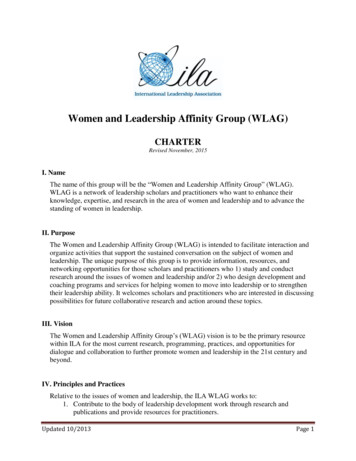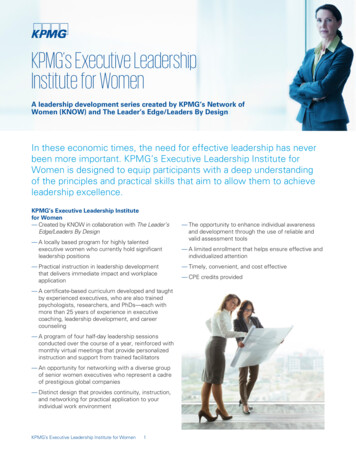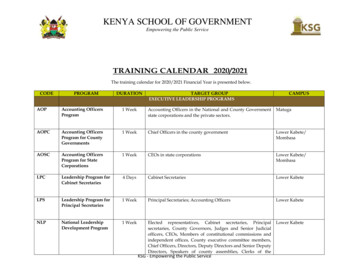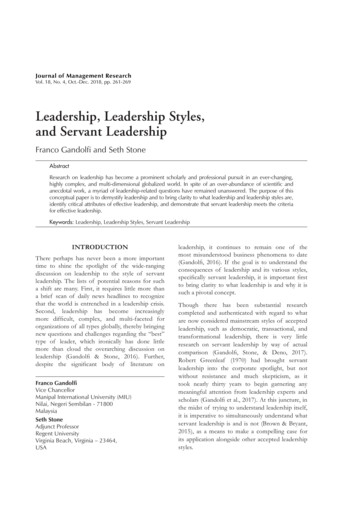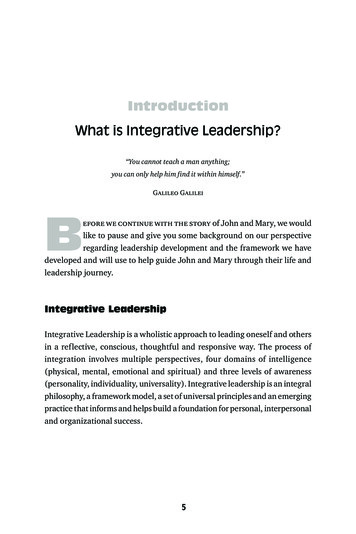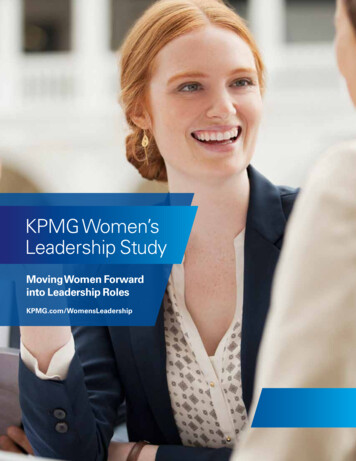
Transcription
KPMG Women’sLeadership StudyMoving Women Forwardinto Leadership RolesKPMG.com/WomensLeadership
Contents1A Commitment to Women’s AdvancementJohn Veihmeyer, Chairman, KPMG InternationalLynne Doughtie, KPMG U.S. Chairman and CEO-elect2The Path to Female Leadership4Key findings8Action Items9Detailed Findings21 Conclusion23 Contact
In a marketplace defined by complexity, disruptionand change, today’s most successful enterprises arethose that bring diverse perspectives and experiencesto each new challenge. Along with being the rightthing to do, diversity and inclusion offer a strategicadvantage – especially at the leadership level.That is why it is critically important for businesses to look at the challenges women often face,and clear the path for talented and dynamic leaders to rise to the top.This understanding – together with our own commitment to fostering a culture at KPMG that is bothdiverse and inclusive – inspired us to commission this study on women and leadership. At KPMG, wehave long believed that creating a work environment where women can thrive, and implementinginitiatives that support, advance, retain and reward them, is not only the right thing to do, it is a smartand strategic business approach.The KPMG Women’s Leadership Study is a comprehensive survey of more than 3,000 professionaland college women, exploring the qualities and experiences that contribute to women’s leadership andadvancement in the workplace. In addition to outlining challenges and opportunities shared with us, thestudy also offers concrete steps that can be taken to move more women into leadership positions.The release of our study coincides with our inaugural KPMG Women’s Leadership Summit, to be heldon-site with the KPMG Women’s PGA Championship. The KPMG Women’s Leadership Summit andfollow-on programming have one objective: to move more women into the C-suite. The summit willbring together today’s most accomplished leaders from the worlds of business, politics, sports and themedia, to inspire the next generation of women leaders.It is our fervent belief that this study will inform and encourage leaders to take clear and decisive stepsto develop the leadership potential of their female employees—and that we will all be stronger for it.John Veihmeyer, Chairman, KPMG International,and Lynne Doughtie, KPMG U.S. Chairman and CEO-elect
2 Research SummaryThe Path toFemale LeadershipA woman’s perception of leadership begins not with collegiateacademic success, her first big break or when she’s named to aposition of power. The trajectory to female leadership starts muchearlier and is defined by key influences throughout life.Imagine a young girl—perhaps a daughter, a niece or thegirl down the street. She is smart. She is ambitious. Shebelieves in herself and her abilities. From a young age, shehas the desire to lead—to inspire others to greatness, tosurpass expectations, to better the world. Yet as she growsup, two elements will affect her ability to lead: confidence andconnections. Throughout her life, she either will receive whatshe needs to build these two key components of leadership—or she won’t.There are many women who serve as models for how tolead and how to become leaders. They’ve taken corporations,governments, academic institutions and other organizationsto new heights. They’ve shown other women the possibilitiesand the power they hold in their own hands. Yet for all theirachievements, these women represent too small a percentageof leaders overall. What experiences moved these womenforward? How can we empower more women to follow in theirfootsteps? The answers to these questions could be critical toempowering all women—and all businesses.Addressing the challengeThe KPMG Women’s Leadership Study, conducted by theindependent research company, Ipsos, on behalf of KPMG,seeks to understand how the aspiration and ambition to leadis developed and nurtured—or not—in women.3,014 U.S. women (2,410 professional working women and 604college women) between the ages of 18 and 64 were surveyedas part of the study.Specifically, the study sought to identify how these womenwere socialized to leadership growing up; explore theirself-perceptions growing up and today; uncover whichcharacteristics are associated with leadership; examine whoinfluenced these women in learning about applying businessleadership; and discover concrete ways to help more womenmove forward into leadership roles. KPMG hopes the insightsderived from this study will help companies identify actions thatwill contribute to women achieving their potential.
Research Summary 3Notably, the findings reveal that there is no shortage ofambition among the women surveyed. Six in 10 of theprofessional working women who responded indicated theyaspire to be a senior leader of a company or organization,and more than half aspire to serve on a board. Yet they alsoreported hesitancy: More than half of the women agree that,“as women,” they are more cautious in taking steps towardleadership roles, and six in 10 find it hard to see themselves asa leader. The results reveal a critical disconnect: Women want tolead, but something is holding them back.The importance of confidence and connections is evidentthroughout the study, highlighting key opportunities toinfluence a woman’s perceptions of leadership. Was sheencouraged to lead as a child? Did she have a role model? Isshe offered appropriate support and development opportunitiesin a corporate setting? Factors such as these becomesignificant milestones in the aspiring leader’s life. If they areavailable to her, she is more likely to move further down thepath to leadership. If they are not, her aspirations of becominga leader are more likely to remain out of reach. In the followingpages, we explore that path to leadership, along with possibleways to pave it for more women.“Having people tell me ‘thisis something you can do’ builtmy confidence.”Candy DuncanChair, KPMG Women’s Leadership Summit
Key Findings:Influences on thePath to Leadership“Just say yes. Use anyfear as motivation to besuccessful. That fear willthen turn into confidence.”Adena FriedmanPresident, Nasdaq
Key Findings 5“Having sponsors that put their own capitaland credibility on the line for me helped memove into a number of leadership roles.”Dalynn J. HochCFO, Zurich North America, Zurich Insurance CompanyThe socialization of leadershipChildhood lessons and early exposure toleadership have a significant impact on awoman’s perceptions of her ability to lead.A woman’s views of leadership begin totake shape early in childhood, startingwith the values she learns, her exposureto leadership skills, and whether she haspositive leadership role models. Professional working women surveyedsaw themselves as “smart” growingup and cited school and academics asthe area where they most felt like aleader. 86% of women recall being taughtto be nice to others growing up; 44%were taught to be a good leader; and34% were taught to share their pointof view. A full three-quarters (76%) of womentoday wish they had learned moreabout leadership and had moreleadership opportunities whilegrowing up.Given their sense of academicachievement—and the predominance offemale students in U.S. colleges today1—we look at what happens to thesebright female students when they enterthe workforce. We see that extendingthe leadership training and positivemessaging some received beginning inchildhood throughout a woman’s careercould help continue the self-perceptionof one’s ability to lead.Modeling leadershipConfidence, the encouragement ofpositive role models and the presenceof a strong professional network shapea woman’s view of leadership in theworkplace.Kelly WatsonKPMG Partner and Board MemberConfidence is an attribute womenthemselves identify as the key toleadership success. Throughout theirprofessional careers, women strugglewith what they characterize as a lack of it. “A way to move more women forwardis to identify high-performing women 67% of women said they need moreand give them stretch assignmentssupport building confidence to feel likethat will help them reach their fullthey can be leaders.potential.” The lack of confidence affects an arrayMaggie Wilderotterof other activities tied to ultimatelyExecutive Chairman, Frontier Communicationsbecoming leaders: nine in 10 womensaid they do not feel confident askingfor sponsors (92%), with largenumbers also lacking confidenceseeking mentors (79%), asking foraccess to senior leadership (76%),pursuing a job opportunity beyondtheir experience (73%), asking for acareer path plan (69%), requestinga promotion (65%), raise (61%), or anew role or position (56%).The results suggest that corporationswould do well to ask themselves whyconfidence is such a struggle for so manywomen in corporate environments.Why do women, who identify withbeing “smart” and as leaders in schoolgrowing up, feel less confident to lead atwork? Initiatives focused specifically onbuilding confidence could help womento leverage—rather than question—theirabilities.Pew Research Center: Women’s college enrollment gains leave men behind. �Relationships are the building blocksof anyone’s life or career, and makingthose connections has been thesingle most critical thing for my careeradvancement.”
6 Key Findings“Recognize when women do great work.Appreciate it. Celebrate it. Reward it.”Michelle Kydd LeeChief Innovation Officer, Creative Artists Agency“To ensure a sustainable pipelineof exceptional female leaders,companies need to be innovative indeveloping programs that provideopportunities for growth andadvancement, while also intentionallyseeking out and encouragingthese high-performing women toparticipate in these programs.”John VeihmeyerChairman, KPMG InternationalReceiving encouragement fromrole models and having a strongprofessional network can also helpwomen bridge the confidence gap.Nine in 10 working women believe thattheir own perseverance will acceleratetheir journey to leadership, but theyalso overwhelmingly agree that femalecolleagues, role models and professionalnetworks play a critical role in advancingwomen’s leadership. 67% of women reported they’dlearned the most important lessonsabout leadership from other women. 82% percent of professional workingwomen believe access to andnetworking with female leaders willhelp them advance in their career.Implementing leadership programsthat develop and connect high-potentialwomen with senior leaders may be keyto helping more women advance.A commitment to moving morewomen forwardInnovative corporate initiatives andsenior female leaders can motivate andreinforce women on their way up thecorporate ladder.Corporations can help women shift fromaspiring to leadership to developingthe confidence to lead and then tobeing a leader in business. Leadershipdevelopment programs and performancereward programs that provide necessaryconstructive feedback as well as a personalvalidation for a job well done—”soft”incentives—can deliver hard results interms of empowering female talent.Integrating this kind of reward systeminto management training and careerarchitecture initiatives complementtraditional rewards of raises andpromotions. More than half of working women(53%) indicate receiving praise fromcolleagues, leaders and mentorsmost influences their perception ofthemselves in the workplace, vs.traditional rewards of raises (39%)and promotions (37%).
“To inspire greatness is to empowerthose around you and to give themthe confidence and opportunities tosucceed.”Suzy WhaleySecretary, PGA of America When asked what training anddevelopment skills were neededto help move more women intoleadership roles in the future,professional working women citedleadership training (57%), confidencebuilding (56%), decision-making(48%), networking (47%), andcritical thinking (46%) most often.Professional working women believeit is critical for companies to support awoman’s development in her twenties(80%) and career advancement in herthirties (61%).Companies will be instrumental inhelping aspiring leaders advance, butwomen are eager to do their part, too.They realize what they do today impactsfuture generations of working women,and they’re prepared to take action tohelp others advance in their careers.With more women in senior leadershippositions today, nine in 10 respondentsreported they are excited about what ispossible. 86% of women report when theysee more women in leadership, theyare encouraged they can get therethemselves. 83% of working women know thesteps they take in business todaywill help set the stage for futuregenerations of women in business. 76% of working women plan topersonally take active steps to helpother women advance in their careers.“Own your career. Don’twait for someone totap you on the shoulderand present an opportunityto you.”Lynne DoughtieU.S. Chairman and CEO-elect, KPMG
8 Action ItemsThe Call to ActionThe research results are clear and there are things that can bedone to move more women into workplace leadership. Beloware some considerations: Actively engage potential leaders. Identify and invest inhigh-performing women with the capacity and inclinationto lead, and give them the confidence to do so. Treat leadership as a tangible skill. Clarify the most valuedand respected attributes of leaders in the organization—strategic thinking, for example—and provide trainingopportunities and confidence building for women who wishto hone their skills. Establish relationships and networks. Actively connectjunior-level employees with female senior leader mentors/sponsors and create networking opportunities regardlessof level. Enhance the visibility of role models. Highlight femalesenior leaders. Chart the path to leadership. Articulate clear steps forcareer development, starting with employees in theirtwenties or earliest stages of their careers. Combine “soft” and “hard” rewards. Reinforce andvalidate women’s performance and confidence with clearand consistent personal feedback, together with the moreconventional rewards of raises and promotions.
9 Detailed FindingsDetailed FindingsThe ChallengeWomen aspire to lead but arehesitant. Why?Being a leader is a professional goalthat seems attainable to the majority ofwomen. Six in 10 women (64%) aspireto be a senior leader of a company ororganization in the future, and more thanhalf (56%) of women aspire to be on theboard of a company or organization. Butat the same time, women are hesitantabout taking a leadership role. Morethan half (56%) of all working womenreported that as women, they are morecautious about taking steps towardleadership roles. Women also reporteddifficulty envisioning leadership in theirfuture. In fact, six in 10 women (59%)indicate they sometimes find it hard tosee themselves as a leader.“I wish I had been encouraged to be moreself-confident and given the opportunity toThe research indicates the important roledevelop leadership skills. I was told I wasthat encouragement plays in addressingthis hesitation. Women who weresmart but not encouraged to lead.”encouraged to be leaders growing up aremore likely to aspire to be a senior leaderof a company or organization (74% vs.48%) and to aspire to be on a board ofa company in the future (66% vs. 39%)than those who did not receive thatencouragement growing up.Working Woman, 40-6456%As a woman, I am more cautious about takingsteps toward leadership roles.Working Women,25-64“If I learned about leadership andhow to be a leader as a child, I thinkit would have taught me to be moreconfident in myself and express myopinions without caring about whatother people think.”College Woman, 18-2459%I sometimes find it hard to see myself as a leader.Women, 18-64Q. Please indicate whether you strongly agree, somewhat agree, somewhat disagree or strongly disagree with each of thefollowing statements.
10 Detailed FindingsExploring theinfluences ona woman’spath toleadership“ I wish I had learned that it’s okay to benice to people and be a leader. Maybeit would have been great to learn howto be nice and how to be a leader atthe same time.”Working Woman, 40-64Lessons learned growing upWomen, 18-64Be nice to others86%Be a good student86%Be respectful to authorities/elders85%Be helpful77%Believe in yourself68%Never give up62%Be a good team player62%Be supportive of others62%Take a stand for what you believe in56%Get involved in something you’re passionate about50%Be a good leader44%Make a difference in society41%Master a skill39%Share your point of view34%Be a good athlete19%OtherNone of these2% 1%Base: Women, 18-64Q. Growing up, which of the following do you recall learning?The socialization of leadershipA woman’s inclination to lead doesn’tbegin in adulthood—it begins yearsearlier, in her childhood. Providingopportunities to lead—and trainingon how to do so—could offer a soundfoundation for future leadership.For many women, doing well in schooland identifying as “smart” initiallyprompts feelings of leadership potential.The majority (86%) of respondentswere instructed to be good students,and seven in 10 (70%) women wouldhave described themselves as “smart”while growing up. School was the mostcommonly cited setting for feelings ofleadership for more than half (58%) ofwomen, followed by others includingjobs (30%), special interest clubs (26%),youth organizations (25%), expressivegroups (25%) and sports (22%).Yet in childhood, women also reportedbeing taught lessons that can underminean inclination to lead—namely, anemphasis on practicing the “goldenrule” rather than being assertive orspeaking one’s mind (see chart, thispage). Two-thirds (65%) of womenreported that when they were younger,they were hesitant to show they couldbe a leader. Interestingly, today’s seniorwomen leaders are more likely thantheir professional counterparts (mid management and entry-level) to recalllearning to share their point of view aschildren (entry-level: 31% vs. mid-level:32% vs. senior-level: 37%).Praise and encouragement from femalerole models may be crucial in helpingwomen develop into corporate leaders.More than six in 10 women (63%)indicated that they were encouraged tobe a leader when they were growing up,and more than eight in 10 women (84%)reported that having positive leadershiprole models helped them feel confidentabout what they could accomplish in life.In fact, three-quarters of women (75%)received praise and recognition whenthey acted like a leader growing up. Mostcommonly, it was their female teachers(68%) and moms (67%) who acted aspositive role models to teach them aboutleadership.
11 Detailed Findings“I wish I would’ve received moreformal training in effectiveleadership, it would have made meless hesitant to step into leadershiproles sooner. It’s difficult as a womansometimes to have to fight for thoseopportunities.”Working Woman, 25-39Learning to leadDespite early encouragement and goodintentions from female role models,women still feel more leadershipopportunities are needed during theformative years. Three in four (76%)women wish they would have learnedmore about leadership when theywere growing up, and that they hadmore opportunities to learn how to leadwhen they were growing up (75%).Senior leaders are more likely thantheir colleagues (mid-management andentry-level) to recall learning to be a goodleader growing up (entry-level: 36% vs.mid-level: 39% vs. senior-level: 49%).Furthermore, those with childhoodleadership experience are more likelythan those without that experience to besenior leaders today.Specifically, growing up: Those who learned to be a good leaderare more likely to be senior leadersthan those who did not (26% vs. 18%). Those who felt like a leader are morelikely to be senior leaders than thosewho did not (23% vs. 11%). Those who were encouraged to bea leader are more likely to be seniorleaders than those who did not (26%vs. 15%).The impact of early positive role modelsis also seen in women during their adultyears. Those who had positive rolemodels growing up are twice as likelyto feel confident today (50% vs. 25%)compared to those who did not havepositive role models.
“I wish I would have learned to be confident and stand up for my beliefs.Just to never be afraid of what others think.”Working Woman 25-39Modeling leadershipIt’s a theme that recurs throughout the study: Confidence is keyfor leadership, but it’s something women struggle with throughouttheir careers. Confidence-building programs, networkingopportunities and the encouragement of role models can offerwomen the support they need to believe in their leadership abilities.Women cited confidence (63%) anddetermination (63%) as the top twocharacteristics of leaders; however, lessthan half of women (49%) personallyidentify with being confident today.Further, confidence was not a strengthfor women in their early years, withless than one-third (31%) of womendescribing themselves as beingconfident while growing up. Entry-levelworking women report the lowest levelsof confidence (44%) compared to theirprofessional counterparts (mid-level:52%, senior-level: 55%), illustrating astrong need for confidence-buildingat the onset of a woman’s career.Building confidence in the workplaceHelping women to develop and sustainconfidence will be key to nurturing themas leaders. Two in three respondents(67%) believe they need more supportbuilding their confidence to feel like theycan be a leader. Almost six in 10 workingwomen respondents believe leadershiptraining (57%) and confidence building(56%) will help move more women intofuture leadership roles. Respondentsalso cited decision-making (48%)and critical thinking (46%) as neededskills. Clearly, a strategic mindset anddecisiveness are characteristics neededfor senior leaders.Women also feel apprehensive aboutclaiming their achievements. Only onethird of the surveyed working womentoday identify with being successful(36%) or accomplished (34%), asentiment shared regardless of ageand level. Further, only one-quarter(27%) of the same working women feelempowered today.When looking at professional roles, thosein entry-level and in mid-managementpositions are more likely than seniorleaders to believe they need moresupport around building their confidenceto feel like they can be leaders (entry level: 75% vs. mid-level: 63% vs. seniorlevel: 56%). In fact, women in entry-levelpositions are more likely than theirprofessional counterparts to indicatethat training articulating and sharing theirpoint of view would help more womenmove into leadership roles in the future(entry-level: 40% vs. mid-level 34% vs.senior-level 34%).This persistent lack of confidence likelyis holding women back professionally.One in four working women (25%) reportthat not asking for what they want heldthem back from advancing in their career.Moreover, six in 10 of the surveyedworking women do not feel confidentasking for a raise (61%) or promotion(65%). This may be related to the factthat only one-third of the women recalllearning to share their point of view(34%) growing up.Creating a ‘circle of trust’Connecting women is essential forthe evolution of female leadership, butbuilding a personal ‘circle of trust’ isnot easily accomplished. A discrepancywas found between the importance ofengaging with other women and therealities of who is doing it. While seven in10 working women (70%) feel a personalobligation to help more women advancein the workplace, only one-third (33%)have learned to leverage and supportother female employees. Unfortunately,eight in 10 working women (79%) do noteven feel confident enough to ask for amentor and nine in 10 (92%) do not feelconfident asking for a sponsor.The data suggests that those whorose to senior leadership and midmanagement positions might havelearned the advantage of engaging withother women, as they are more likelythan their professional counterpartsto indicate they learned to be goodmentors/sponsors from positive rolemodels (entry-level: 49% vs. mid-level58% vs. senior-level 60%).Unfortunately, career-relatedconversations among women tendto turn negative. Seven in 10 womenreported that they are more likely to talkto other women about the challengesaround career advancement rather thanthe opportunities. This is more commonamong younger working women, ages25-39 than it is among more seniorworking women, ages 40-64(65% vs. 72%).
13 Detailed FindingsItems women feel confident asking for in their careerAdditional training/professional development59%A flexible schedule52%A special project48%48%A new role/position52%44%Additional resources56%42%A raise58%39%A promotion61%35%A career path plan65%31%A job opportunity beyond my expertise41%69%27%73%Access to senior leadership24%76%Increased budget22%78%A mentorA sponsorOtherI would not be confident askingfor any of these21%“I would thank myrole model forbelieving in me, forbolstering my selfconfidence. I’vealways been sortof shy and unsureof myself, so havingsomeone else’ssupport has beenreally essentialto me.”College Woman 18-2479%8%92%1%99%5%ConfidentNot confidentBase: Working women, 25-64Q. Which of the following would you feel confident asking for in your career?
14 Detailed Findings“[I would thank my role model] forbelieving in me, for bolstering myself-confidence. I’ve always beensort of shy and unsure of myself, sohaving someone else’s support hasbeen really essential to me.”College Woman 18-24Sharing leadership lessonsThe lessons imparted by female rolemodels can be invaluable, surveyresponses indicated. Female friends(51%), female colleagues (44%), andfemale professional peers (43%) playa significant role in teaching workingwomen about applying businessleadership. Two-thirds (67%) of womenhave learned the most important lessonsabout leadership from other women.As a matter of fact, this significanceextends to the next generation, as theoverwhelming majority (91%) of workingwomen indicated that it is importantto them to be a positive role modelfor younger female colleagues in theworkplace.Younger working women ages 25-39 aremore likely than their senior counterpartsto have had a role model teaching themabout applying business leadership (93%vs. 89%), particularly female role models(91% vs. 84%). Working women ages40-64 are more likely than their youngercounterparts to indicate that being apositive role model to others helpedthem advance in their career (40% vs.30%).More women in senior leadershipreported having significant positive rolemodels teaching them about applyingleadership than that reported by theirprofessional counterparts (entry-level:29% vs. mid-level: 35% vs. senior-level41%). Interestingly, men’s historicalprominence in corporate America hasplayed an important part in development,as female senior leaders are more likelythan their professional counterpartsto indicate that they learned the mostimportant lessons about leadership frommen (entry-level: 54% vs. mid-level: 52%vs. senior-level: 67%).70%Women, 18-64I am more likely to talk to otherwomen about the challengesaround career advancementrather than the opportunities.70%Working Women, 25-64I feel a personal obligation tohelp more women advance inthe workplace.Q. Please indicate whether you strongly agree, somewhatagree, somewhat disagree or strongly disagree with each of thefollowing statements.
15 Detailed Findings“I’m inspired by the next generation of womenleaders. When I see their potential, I want tohave more of an impact and pay it forward.”Kathy Hopinkah HannanNational Managing Partner, Corporate Responsibility & Diversity, KPMGThe presence of women in leadershippositions and the opportunity to networkcan help motivate women to advancein their careers. Nearly nine in 10 (88%)are encouraged by the women theysee in leadership today and more thaneight in 10 (86%) noted that when theysee more women in leadership, theyare encouraged they can get therethemselves. Eight in 10 working women(82%) believe access to and networkingwith female leaders will help themadvance in their career, regardless ofprofessional level.Working women’s top 5 significant positive role models in learningabout and applying business leadership51%Female friend(s)44%Female colleague(s)Female professional peer(s)MothersMale significant others/husband43%41%39%Base: Working women, 25-64Q. Which of the following people are significant positive role models for you today in learning about and applying business leadership?“I would thank my role model forhaving confidence in me so that Ideveloped it in myself.Thank youfor taking the time to teach me tobe a better leader; thank you forempowering me and giving meextra responsibility along theway, but always being there ifI needed you.Working Woman 40-6482%Access to and networking with female leaderswill help me advance in my career.Working Women, 25-6488%I am encouraged by the women I see inleadership today.Women, 18-6486%When I see more women in leadership,I am encouraged that I can get there myself.Women, 18-64Q. Please indicate whether you strongly agree, somewhat agree, somewhat disagree or strongly disagree with eachof the following statements
16 Detailed FindingsA commitment to movingmore women forwardCorporations have a clear role in cultivatingwomen leaders. Providing women with accessto career development programs and ongoingpositive feedback could propel them furthertoward leadership.Companies can drive growth inwomen’s leadershipRespondents indicate that corporateAmerica can help shape the future forwomen in business. Working womenbelieve that companies supportingwomen (21%) and women supportingwomen (21%) have the greatest capacityto drive growth in women’s leadership. Inparticular, many respondents believe it iscritical for companies to most support awoman’s career development during hertwenties (80%) and career advancementduring her thirtie
The KPMG Women's Leadership Study is a comprehensive survey of more than 3,000 professional and college women, exploring the qualities and experiences that contribute to women's leadership and advancement in the workplace. In addition to outlining challenges and opportunities shared with us, the

